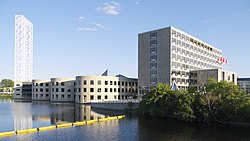John_G._Diefenbaker_Building
John G. Diefenbaker Building
Office building in Ottawa, Canada
The John G. Diefenbaker Building is a building in the New Edinburgh neighbourhood of Ottawa, Ontario. The building served as Ottawa's city hall from August 2, 1958, to January 1, 2001, and afterward was commonly known as Old City Hall. Purchased in 2003 by the Government of Canada, it was known by its municipal address, 111 Sussex Drive, until September 2011 when it was renamed after Canada's 13th prime minister, John Diefenbaker.[1] The building is located on Green Island where the Rideau River empties into the Ottawa River.
This article needs additional citations for verification. (May 2009) |

